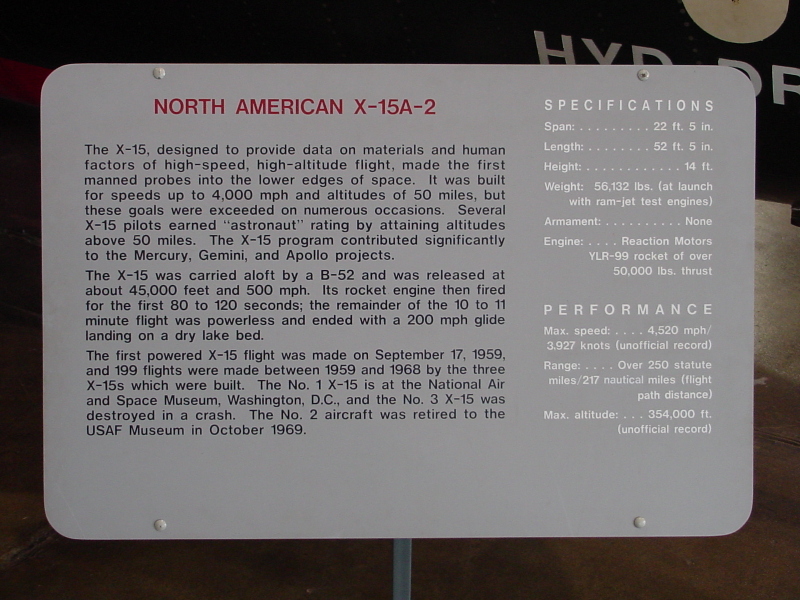| Prev |
heroicrelics.org Air Force Museum Site Index X-15 Gallery |
Next |
dsc04448.jpg
The sign accompanying the X-15. It reads
North American X-15A-2
The X-15, designed to provide data on materials and human factors of high-speed, high-altitude flight, made the first manned probes into the lower edges of space. It was built for speeds up to 4,000 mph and altitudes of 50 miles, but these goals were exceeded on numerous occasions. Several X-15 pilots earned "astronaut" rating by attaining altitudes above 50 miles. The X-15 program contributed significantly to the Mercury, Gemini, and Apollo projects.
The X-15 was carried aloft by a B-52 and was released at about 45,000 feet and 500 mph. Its rocket engine then fired for the first 80 to 120 seconds; the remainder of the 10 to 11 minute flight was powerless and ended with a 200 mph glide landing on a dry lake bed.
The first powered X-15 flight was made on September 17, 1959, and 199 flights were made between 1959 and 1968 by the three X-15s which were built. The No. 1 X-15 is at the National Air and Space Museum, Washington, D.C., and the No. 3 X-15 was destroyed in a crash. The No. 2 aircraft was retired to the USAF Museum in October 1969.
Specifications Span: 22 ft. 5 in. Length: 52 ft. 5 in. Height: 14 ft. Weight: 56,132 lbs (at launch with ram-jet test engines) Armament: None Engines: Reaction Motors YLR-99 rocket of over of 50,000 lbs. thrust [heroicrelics: all other sources I've seen refer to the engine as the "XLR-99"]
Performance Max. Speed: 4,520 mph/3,927 knots (unofficial record) Range: More than 250 statute miles/217 nautical miles (flight path distance) Max altitude: 354,000 ft (unofficial record)

| Time picture taken | Fri Oct 31 11:19:14 2003 |
| Location picture taken | Research and Development/Flight Test Gallery Air Force Museum Dayton, OH |
| Prev | X-15 Gallery | Next |